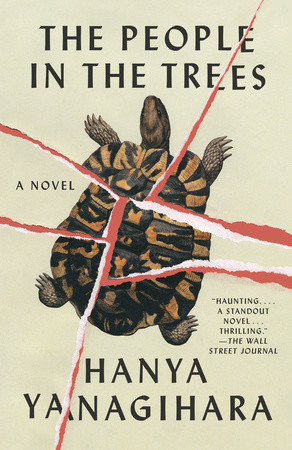By virtue of the fact that I work in publishing, I am always being introduced to new literature and often have my nose in a good book. It is a rare thing, though, for me to be overcome by a story and to enjoy it so immensely that I feel compelled to ardently promote it to anyone who will listen. THE PEOPLE IN THE TREES by Hanya Yanagihara is one of those few books I’ve come across in recent memory that thoroughly captivated me, and well before I even held it in my hands.
I first heard about THE PEOPLE IN THE TREES in an issue of Publishers Weekly, where they named it their favorite book of 2013. Their glowing review detailed a story of scientific discovery, a lost tribe that seems to hold the key to immortality, and a provocative unreliable narrator. Researching further, I learned that the author set her novel on a fictional island in the South Pacific as a way to indirectly write about her native Hawaii. Her narrator and his study of a previously uncontacted tribe and their impossibly long lives had dual inspiration: Yanagihara’s lifelong exposure to the culture of scientific research through her father’s laboratory, and from real-life Nobel Prize winner D. Carleton Gajdusek, who first studied an incurable disease in a tribe living in Papua New Guinea.
I was so intrigued by the premise of this book that I became fixated on reading it, and I immediately sought it out at the bookstore. But the high expectations I had built were far exceeded by the book itself once I cracked the spine.
THE PEOPLE IN THE TREES is structured as organized source materials with the central text consisting of the memoirs of Dr. Norton Perina, a scientist reflecting on his experiences during an anthropological expedition to the Micronesian island of Ivu’Ivu and its impact on his life in the subsequent years. From the outset, the reader learns that Perina is writing his memoirs from prison, where he is serving a sentence for child molestation. Perina’s narrative is edited and occasionally supplemented with commentary and footnotes from Perina’s adoring colleague and advocate for his innocence, Dr. Ronald Kubodera.
The story begins with Perina’s modest roots and his entry into medical school, his tone making his arrogance, ambition, and brilliance strikingly clear. Once he arrives on Ivu’Ivu, he is captivated by the island and its people, all the while taking meticulous notes and cataloguing his observations: anthropologic, botanical, and linguistic. Through Perina’s scholarly detail and supplemented by Kubodera’s regular footnotes, Yanagihara beautifully and carefully constructs the island and its inhabitants. The text explores the unique species of flora and fauna, tribal mythology, and even goes so far as to discuss the structure of the Ivu’Ivuan language, breaking down the fictional tongue at the morphological level. (At the back of the book there is also a glossary of Ivu’Ivuan terms—yet another wonder of the precision of Yanagihara’s literary invention.) The result is such an astoundingly thorough picture of a place and its people—the most realistic I’ve ever encountered—that the author successfully establishes a kind of Ivu’Ivuan mythos. And as Perina’s fascination with and connection to the island deepen, I likewise found myself increasingly invested in Perina and his success despite growing evidence of his darker nature.
Difficult cultural questions come into play as Perina and his research colleagues are welcomed more intimately into the island culture, and Perina’s relationship with the tribal way of life in contrast to Western sentiment both earns him sympathy and raises cause for alarm. The clash of cultures and repercussions of Perina’s research are clear critiques of colonialism, but the story is so rich in literary allusions that the prevailing association is that of Nabokov. Perina is not nearly as elaborate in his use of language or self-righteous in his defenses as Humbert Humbert (he is a scientist, after all), but the lyricism and loveliness of LOLITA echoes throughout THE PEOPLE IN THE TREES in the most delicious way.
Numerous themes rear their head in this incredibly haunting book—power, ethics, the loss of innocence, and sex, to name a few—and after the tumultuous ride through Perina’s life, the book leaves you feeling a bit dirty and bedraggled, exhausted from investing in a world that is unjustly ravaged and wrangling with questions of morality. Most of all, it leaves you reeling from the powerful confession in its final lines. THE PEOPLE IN THE TREES is a challenging and important story, and the most remarkable feat of fiction I’ve read in years.








